While it sounds futuristic, the concept of “smart cities” isn’t all that new. In fact, many cities have already adopted smart solutions, while others are taking advantage of new technology and the Internet of Things (IoT) to pilot new programs and fuel innovation in nearly every part of our lives.
Although there’s no one definition of what makes a city “smart,” most agree that it’s the integration of connected devices that collect data via sensors and then use that data to improve city efficiency, performance and livability. In short, the more data a smart city is able to collect, analyze and share, the more ways cities can improve their infrastructure.
And with more than half of the world’s population already living in cities (and that number rising), improvements are crucial to meet the growing demands of decent city living. Thankfully, technology is playing a central role in alleviating many of the pain points.
Sensors and 5G: Essential for Smart Cities
At the root of the latest smart city advancements are embedded sensors that wirelessly connect infrastructure via Wi-Fi, cellular or Long Range Wide Area Networks (LoRaWAN). LoRaWAN, in particular, plays a large role in deploying IoT solutions across smart cities as it can provide long-range connectivity and coverage, even where Wi-Fi cannot. LoRaWAN also enables sensors to network together with hotspots, eliminating the need for separate cellular connections, which results in significant cost savings.
Another reason cities are getting “smarter” is the 5G cellular networks that are coming online. As the foundation of IoT enablement, this network offers lower-cost, high-speed connectivity, low latency and vast coverage, making the technology ideal for powering large-scale smart functions.
Smart Transportation and Mobility
With transportation and mobility being major pain points in urban areas, IoT and 5G are fueling smart applications that create efficiencies, convenience and safety. One such application currently being piloted or in use in cities across the globe are sensors that coordinate traffic and reduce congestion by automatically changing traffic lights to reflect peak periods. For example, lights stay green on high-volume roads for longer periods, thus reducing congestion.
Cities are also deploying IoT-enabled apps that identify and notify drivers of open parking spaces. This might seem minor, but in large cities, drivers spend a lot of time driving around looking for parking spots, which contributes both to congestion and pollution.
Convenience is another major factor in attracting and retaining city dwellers. Planning a smart city that offers easy mobility is essential. Smart applications that help eliminate the hassles of city living include digitizing paper such as subway tickets or IDs so they can be accessed on smartphones. Furthermore, automating these functions eliminates the need for paper tickets, which results in environmental and cost savings.
One community that’s leading smart city mobility is Washington D.C. Its movement analytics program uses data from video cameras to identify where and what types of vehicles are moving through the city, including cars, buses and bikes (pedestrians are also identified). This data is then analyzed and used to make better decisions about how to direct traffic and identify where more resources, such as bike lanes, are needed.
Environmental
Many of the examples discussed above also aid sustainability, another goal for smart cities. Transportation is one of the largest contributors of carbon dioxide in our atmosphere. Alleviating traffic congestion reduces the CO2 footprint, creating environmental efficiencies.
Some smart cities are also taking innovative approaches to make their cities safer for citizens. One example is automated air quality monitoring and testing, which helps residents make informed decisions about whether they should take precautions, such as limiting time outdoors due to pollen, wildfire smoke or smog. Other smart technologies making cities more sustainable (and pleasant) include garbage cans that send an alert when they’re full and need to be emptied, and streetlights that automatically dim when they’re not needed.
Many cities are centering their smart city strategy around sustainability. Take Austin, Tex., for instance. It has a Smart City Challenge focused on mobility enhancements, including “smart stations” that provide services for connected vehicles and fleet electrification, a program that increases the number of electric vehicles within the city.
Privacy Concerns
While the smart cities concept is positive in most ways, it does raise privacy and security issues. To work smart, cities rely heavily on collecting massive amounts of citizen data, and this is a topic of much discussion within the industry. To ensure privacy and reduce liability, standards must be set and local governments must be prepared to proactively notify users how their data will be used. There are also data privacy programs that address these concerns and ensure data is being used safely and with the goal of providing cleaner, faster, safer, more efficient and more sustainable cities.
Enabling Today’s Smart Cities
Always forward-thinking, Digi-Key aims to continually partner with suppliers that are enabling innovative smart city solutions. In partnership with Supplyframe, TE and Microchip, the company recently launched a three-part online video series called “City Digital,” which highlights some of the world’s “smartest” cities and showcases how the latest technology and innovations are reshaping the way people work, commute and live in cities today.
About the Author
Robbie Paul
Robbie Paul is director of IoT Business Development at Digi-Key Electronics. Digi-Key is one of the world’s largest full-service distributors of electronics components, offering more than 11.8 million products—with over 2.6 million in stock and available for immediate shipment—from more than 1,700 quality, name-brand manufacturers.






